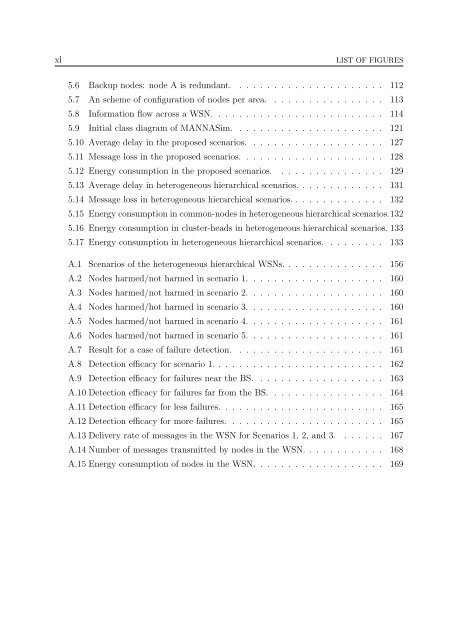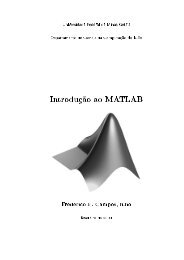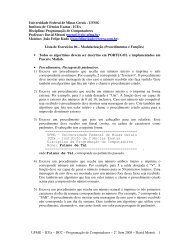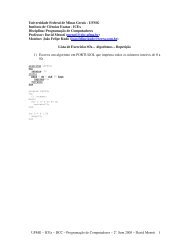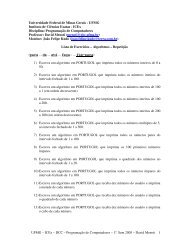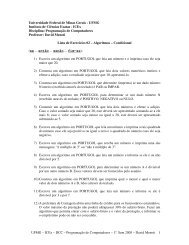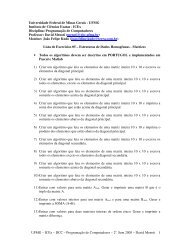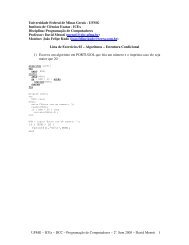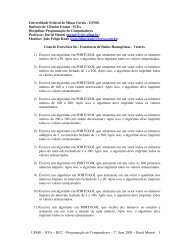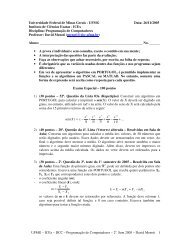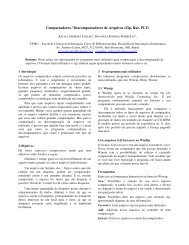MAN´A: Uma Arquitetura para Gerenciamento de Redes de ... - UFMG
MAN´A: Uma Arquitetura para Gerenciamento de Redes de ... - UFMG
MAN´A: Uma Arquitetura para Gerenciamento de Redes de ... - UFMG
Create successful ePaper yourself
Turn your PDF publications into a flip-book with our unique Google optimized e-Paper software.
xl LIST OF FIGURES<br />
5.6 Backup no<strong>de</strong>s: no<strong>de</strong> A is redundant. . . . . . . . . . . . . . . . . . . . . . 112<br />
5.7 An scheme of configuration of no<strong>de</strong>s per area. . . . . . . . . . . . . . . . . 113<br />
5.8 Information flow across a WSN. . . . . . . . . . . . . . . . . . . . . . . . . 114<br />
5.9 Initial class diagram of MANNASim. . . . . . . . . . . . . . . . . . . . . . 121<br />
5.10 Average <strong>de</strong>lay in the proposed scenarios. . . . . . . . . . . . . . . . . . . . 127<br />
5.11 Message loss in the proposed scenarios. . . . . . . . . . . . . . . . . . . . . 128<br />
5.12 Energy consumption in the proposed scenarios. . . . . . . . . . . . . . . . 129<br />
5.13 Average <strong>de</strong>lay in heterogeneous hierarchical scenarios. . . . . . . . . . . . . 131<br />
5.14 Message loss in heterogeneous hierarchical scenarios. . . . . . . . . . . . . . 132<br />
5.15 Energy consumption in common-no<strong>de</strong>s in heterogeneous hierarchical scenarios.132<br />
5.16 Energy consumption in cluster-heads in heterogeneous hierarchical scenarios. 133<br />
5.17 Energy consumption in heterogeneous hierarchical scenarios. . . . . . . . . 133<br />
A.1 Scenarios of the heterogeneous hierarchical WSNs. . . . . . . . . . . . . . . 156<br />
A.2 No<strong>de</strong>s harmed/not harmed in scenario 1. . . . . . . . . . . . . . . . . . . . 160<br />
A.3 No<strong>de</strong>s harmed/not harmed in scenario 2. . . . . . . . . . . . . . . . . . . . 160<br />
A.4 No<strong>de</strong>s harmed/hot harmed in scenario 3. . . . . . . . . . . . . . . . . . . . 160<br />
A.5 No<strong>de</strong>s harmed/not harmed in scenario 4. . . . . . . . . . . . . . . . . . . . 161<br />
A.6 No<strong>de</strong>s harmed/not harmed in scenario 5. . . . . . . . . . . . . . . . . . . . 161<br />
A.7 Result for a case of failure <strong>de</strong>tection. . . . . . . . . . . . . . . . . . . . . . 161<br />
A.8 Detection efficacy for scenario 1. . . . . . . . . . . . . . . . . . . . . . . . . 162<br />
A.9 Detection efficacy for failures near the BS. . . . . . . . . . . . . . . . . . . 163<br />
A.10 Detection efficacy for failures far from the BS. . . . . . . . . . . . . . . . . 164<br />
A.11 Detection efficacy for less failures. . . . . . . . . . . . . . . . . . . . . . . . 165<br />
A.12 Detection efficacy for more failures. . . . . . . . . . . . . . . . . . . . . . . 165<br />
A.13 Delivery rate of messages in the WSN for Scenarios 1, 2, and 3. . . . . . . 167<br />
A.14 Number of messages transmitted by no<strong>de</strong>s in the WSN. . . . . . . . . . . . 168<br />
A.15 Energy consumption of no<strong>de</strong>s in the WSN. . . . . . . . . . . . . . . . . . . 169


